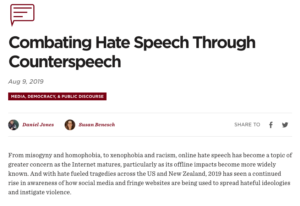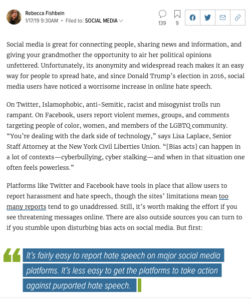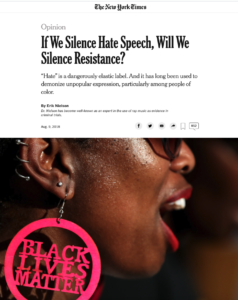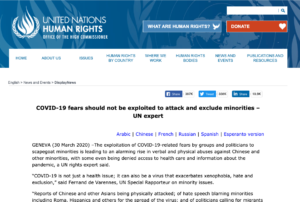Week 5: Taking action
Positive Messengers Project
How to End Hate Speech – Some Good Ideas That Actually Work
How can we come together to counter hate speech in our own contexts? The Positive Messengers Project gives examples of real initiatives in 7 countries that creatively target hate speech in their specific environments.
gPr_news
Watch Video
Over Zero
Counteracting Dangerous Narratives in the Time of COVID-19
‘Over Zero’, has developed a guide for community leaders to address communication that can fuel group-targeted harm and violence. In this two-page summary, you can see the importance of purposeful communication to challenge harmful narratives.
For the full guide, see our Additional Resources section for this week.
Watch Video
Teaching Tolerance
Countering Online Hate Speech
Watch this video to learn about a hands-on approach to counter hate speech online.
Watch Video
Susan Benesch
Combating Hate Speech Through Counterspeech
Efforts to combat hate speech online frequently focus on deleting hateful content. In this article, Daniel Jones and Susan Benesch argue that using ‘counterspeech’ can also be an effective tactic that does not interfere with freedom of expression. Read the article here >

Watch Video
Rebecca Fishbein | LifeHacker
How to Identify and Report Hate Speech on Social Media
Reporting hate speech to social media platforms is a tactic that is easy to participate in. Rebecca Fishbein shares how to report content on popular platforms, the possible outcomes of reporting, and when to get external authorities involved. Read the article here >

Watch Video
Additional Resources
Interested to learn more about this week’s topic? We have selected some additional optional materials for you.
Watch Video
Week 4: Countering Hate Speech or Limiting Freedom?
Misheel Enkh-Amgalan
Hate Speech versus Freedom of Expression
Freedom of expression is a fundamental right. The question to which extent free expression may be practised has been debated since it was mentioned in early human rights documents. Should we label some forms of hate speech as free expression? Or should we limit freedom of expression, in order to, for example, protect targets of hate speech? In this video, Misheel is helping us to explore these questions.
Watch Video
Nadine Strossen
Social Media and Hate Speech: Who Gets to Decide?
Nadine Strossen, the former president of the ACLU, argues that censorship does more harm than good—especially when it comes to social media platforms. She defends that instead of censoring these discourses, social media should be used to identify these and counter them, allowing for the counterspeech to also be disseminated.
Watch Video
EURACTIV
Freedom of expression in Europe: Who draws the line?
In this video we meet panelists from a forum on the current challenges to freedom of expression. We hear their different perspectives on where the line between freedom of speech and hate speech should be drawn, what implementing this has looked like in different contexts, and the positive and negative outcomes of this implementation.
Watch Video
Dr. Nielson
Is it possible that restrictions on hate speech meant to protect minorities can become tools to marginalize them even more? Dr. Erik Nielson argues that this can be the case, and that measures against hate speech that are too broad could end up silencing unexpected voices. Read the article here >

Watch Video
Week3: Human Rights Perspective on Hate Speech
Misheel Enkh-Amgalan
What are Human Rights?
Human Rights are often considered an abstract concept, yet they are about concrete life situations and they form the very basis on which the system has been built. But why are they important and relevant to hate speech? In this video, Misheel explores the definition and characteristics of Human Rights and why they are essential to fight against hate speech.
Watch Video
Misheel Enkh-Amgalan
The Human Rights Protection System
How can we access Human Rights? And how can they be respected and implemented? Misheel explores with us the responsibilities of States in relation to human rights, the institutions ensuring that they are protected, and how Human Rights can be claimed.
Watch Video
A Human Rights Approach to Hate Speech
Hate speech is a violation to human rights, and any response should not reproduce hate, discrimination or violence. But what is a human rights approach to tackling hate speech in practice? In this video, Martin is explaining what are the different questions you should ask yourself to ensure your action is rooted in human rights.
Watch Video
Week 2: Impact and Consequences of Hate Speech
Misheel Enkh-Amgalan
Causes and consequences of Hate Speech?
Whatever the definition of hate speech is, this is not an abstract concept. Hate Speech has clear consequences on the everyday life of people, both on the individual and collective leel. But where does hate come from? In this video, Misheel explores the roots causes of hate speech and the multi-faceted impact it has in our society.
Watch Video
Intersectionality in relation to hate speech
One is almost never solely privileged or marginalised. No person only belongs to one social group but has multiple identity affiliations at the same time. For example, a gay Black man working in the care business may feel related to various social groups at the same time: man, black or African culture, LGBTQI+, and care workers. The privilege of a person can then be seen at the intersection of multiple identities: being male can imply some benefits, while being gay may not. Our benefits are defined in relation to others. For example, one group is privileged, white people, while others are not, non-white people. In this video, Emilia Roig is explaining the concept of intersectionality in relation to hate speech.
Watch Video
COVID-19 fears should not be exploited to attack and exclude minorities
The effects of COVID-19 have not been contained just to the realm of public health. This statement by the UN Special Rapporteur on minority issues draws attention to how COVID-19-related fears have been exploited to increase xenophobia, exclusion, and abuse towards Chinese and other minorities. Read it here >

Watch Video
Preparing to take action against hate speech
Hate speech is complex and there is no “one-fits-all” responses to the phenomenon. The action depends on the instance of hate speech, our relation to that instance, what we want to achieve with our intervention and what tools we have. In this video, Martin suggests steps to prepare to take action, and gives an overview of all the possibilities that exist to fight effectively against hate speech.
Watch Video
Week 1: Setting the Scene
Misheel Enkh-Amgalan
What is Hate Speech?
Hate speech is everywhere today: on the media, online, offline, in the streets and walls. Not a single day passes without us reading hateful comments on the latest music video on YouTube or hearing about the latest controversial Tweet of a politician. But what is really hate speech? How can we define it? In this video, Misheel is giving her first insights to help us to define the phenomenon.
Watch Video
Misheel Enkh-Amgalan
Forms of hate speech
Hate speech is often understood as only covering verbal expressions. But hate speech can take many forms. Sometimes it is very difficult to understand whether or not there is hate. Are some forms of hate worse than others? In this video, Misheel gives keys to assess and identify hate speech.
Watch Video
Misheel Enkh-Amgalan
What hate speech is, is controversial
Identifying the intention to do harm is one of the most important tasks to define hate speech. In many cases, however, the intention of the person can be unclear, or hate speech can be implicit, which makes it very difficult to detect. In this video, Misheel explores, how the vistim’s point of view can help in clarifying the intention of the ‘perpetrator’, while highlighting the limits it poses.
Watch Video



